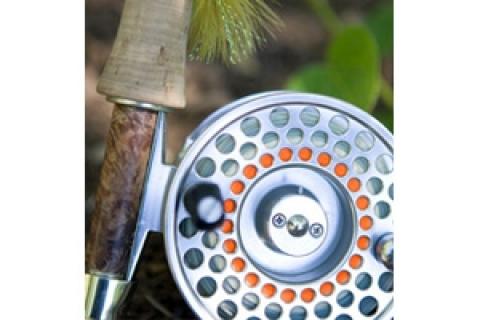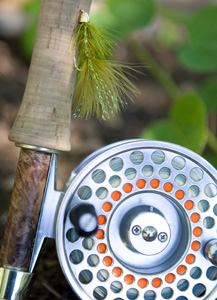
When it comes to trout fishing success and discovering the thrill of winching in a big one, it's important to remember that each piece of your angling gear plays a pivotal role in your success. A line serves as the direct contact between you and the fish, and the rod helps to move and manage your line — and that trout. A reel with its housing, frame and gears, helps to manage the line that's participating in the action — and the length of line that's waiting in reserve. The ultimate test of any reel is a huge fish that lunges forward and pulls the leader and line in tow. This heart-stopping wild fish action can make any angler sweat as the reel screams and yards of fly line disappear underwater. Are you and your reel up to the challenge?
A Fly Reel's Role
 |
| Fly reels help manage the line that's in on the action, as well as the line waiting in reserve. |
A reel has one sole purpose-to help you manage the fly line. Without a reel, you'd be tripping over excess line and working feverishly to intake or release line with each cast. Having the proper reel affixed in the rod seat and anchored below the handle on any fly-rod can mean more controlled fishing action — and less frustration. A quick check in any well-stocked fly fishing supply outlet, like a White River Fly Shop, can produce many reel models. So which one is right for you?
Well, it all depends. In addition to finding a match for the rod and line weights that you'll be casting, you will also have to consider whether you want a cork, synthetic, disc, washers or a click drag system. Drags are the brakes that slow or stop the spool and put tension on the line and the fish on the other end. While cork was once the favorite here, new materials like graphite or carbon fiber have caught anglers' attention and acceptance. As a rule, however, forgo any plastic parts here. Also note that an enclosed drag tends to last longer, so select the system with attention to details. Remember that trout streams are a land of abrasive rocks and fine sand and that sand can grind reel parts until they stress and break. For ultimate performance, be certain that you can easily adjust the reel's drag system. On some reels this is not an easy option.
Next, sturdy fly reels are constructed from metals, and machined aluminum seems to receive the favored nod here today. Some reels are actually die cast. Design also plays a role in performance. An open reel housing and spool permits any wet fly line to rapidly dry, and this "less" design reduces the reel's total weight considerably. As for the overall finish of the reel's exterior, there are two schools of thought: a dull and subdued finish or the shimmering and shiny appearance.
In some cases the brightness is made to catch anglers' attention and promote a purchase. Some anglers, however, think that the glimmer and flash from a reel can spook alert trout and reduce your chances of a strike. Fully understand what metals and finishes — anodized, plated or possibly paint — are used on the reel you are considering and how corrosion resistant the reel is. Rust and metal surface problems can happen when reels are exposed to prolonged periods of moisture and abrasions. That rust can lead to failures.
Any reel selection should also be based on a standard-sized reel or a large-arbor design. Large arbor reels generally pull in the line faster and can be a help on large rivers or bodies of water. This bigger reel, however, could be overkill on many small creeks where fish have to be finessed to hand.
You should plan ahead for your next cast. It's important to note that some anglers turn a reel's handle with a right hand, while others turn with a left hand. I hold the rod in and cast with my right hand, and I operate the reel with my left hand, so I want the handle on the reel's left side. Be certain that the reel can be transformed from a right- to left-hand retrieve if necessary.
Finally, there's the reel's price tag. What are you and your wallet comfortable with?
 |
| Don't forget to ask the fly shop attendant to load the backing and fly line onto the reel. |
When looking beyond a reel's design, appearance and features, you'll also need to look at your fishing habits and haunts in the decision process. Answer questions about what rivers do you regularly fish and how much line must you manage when casting and retrieving. If you like to fish deep in one pool with a weighted line and then cast on the water's surface over the next pool, look possibly at the option of quick-changing spools and buying and packing spare spools. Having an extra spool is a handy feature in the spring when you must often switch between dry flies on the surface and then next running weighted lines and nymphs subsurface in your quest for trout. This ease-of-adaption can make your time invested in a fishing trip more rewarding — especially when the trout cooperate.
No personal reel review would be complete without looking at the overall design, precision fits and total package resulting in a smooth reel operation. Is this small winch sturdy enough to turn red hot as a lunker trout turns, runs and pulls line until the reel screams? Weigh the features and construction as you decide on the best reel for you.
Beyond the Base Features
Once you've settled on a fly reel's design, size and other mechanical features, it's time to study the fine print and your "after-the-purchase" support. If you are going to drop a couple of $100 bills on the counter to obtain a reel, does it have a warranty or does the store stand behind your satisfaction? On stream performance, it's hard to evaluate when you can only make a few rotations of the reel and bare spool or twirl handles at a store counter. Since you and the reel will work as partners to manage line and the fish you encounter, this team should be a perfect match.
If the reel you purchase does not come with a storage case, buy one before you leave the store or complete your order. Some of the most damaging environments for any reel are encountered during travels. I once had a reel bounce of the roof of a van and land on the highway after I had placed it there and forgot to pack it in my tackle bag. A padded cover prevented damage — and my shedding tears.
When you take a fishing trip, make rigging the rod and reel the last thing you do before actually starting to fish and the first task completed when you finish fishing and return to the vehicle or lodge. This prevents possible breaking a rod or damaging a reel — and drastically raising your frustration level. A better method is rigging up at the pool or stretch of water where you plan to make that first cast of the day.
Hopefully your reel will assist with your casts, retrieves and other trout related tasks. Study a reel purchase with as much or more attention to detail as you would a map of a new river that you plan to fish. If you are still undecided on what reel to buy, maybe a rod and reel fly combo package is the answer for you. In this case, you let the manufacturer decide what reel best partners with a specific rod. To help prepare for your next fishing trip, any store should be able to load the backing and fly line onto the reel for you. This is a service I always seek!
Go trout!
- 5847 views

